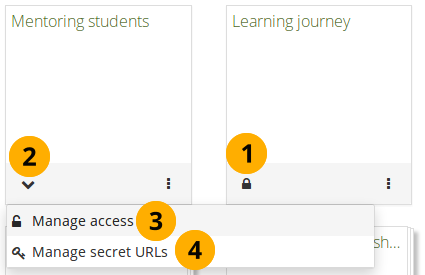5.1. Pages and collections¶
Portfolio → Pages and collections
A page contains a selection of artefacts which you arrange and present to others. These may include:
selected files
résumé details
text (your added commentary, instructions or orientation)
journal posts
video and audio files
RSS feed to an external blog
etc.
You can re-use the artefacts that you collected under Content in as many pages as you wish.
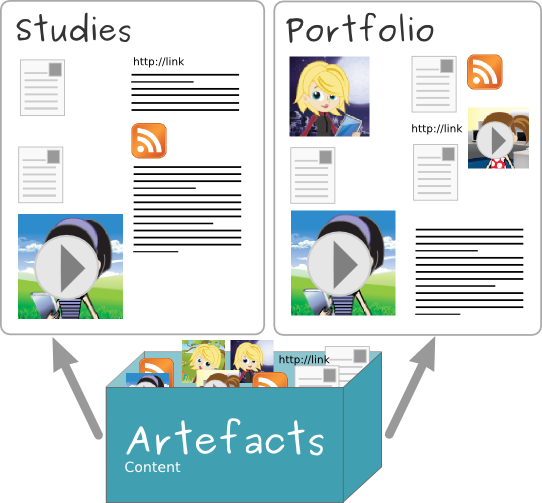
The same artefacts can appear in multiple pages¶
5.1.1. Overview page¶
On the landing page of Portfolio, you can do the following.
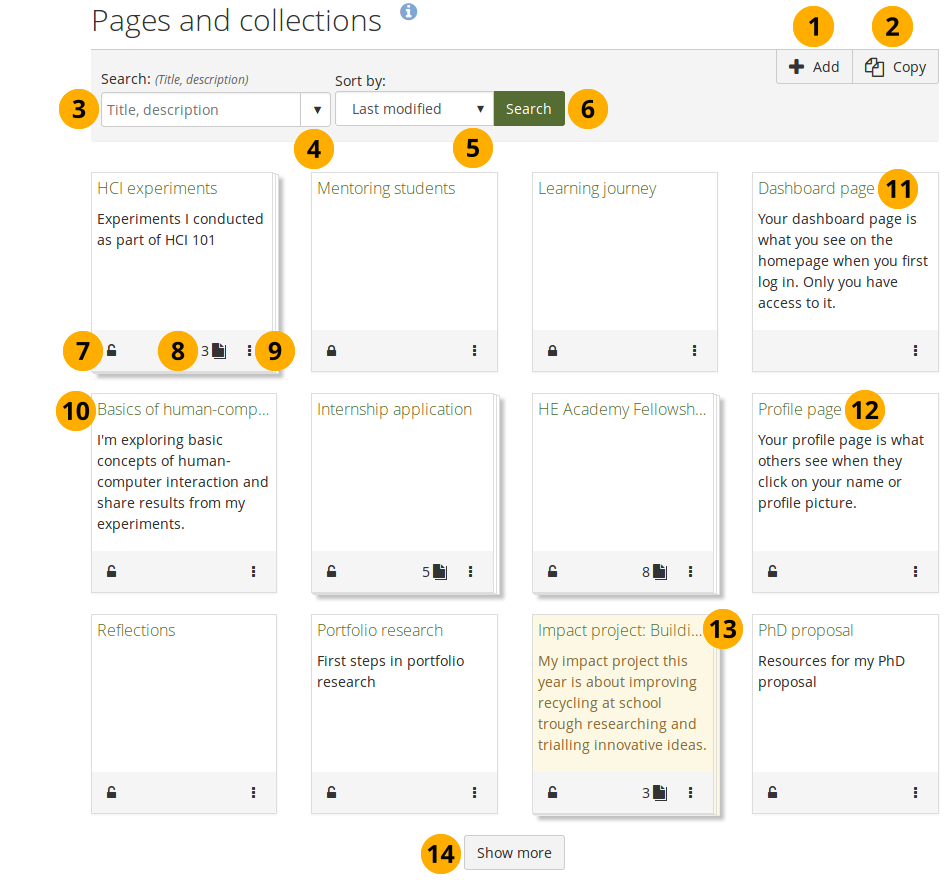
The landing page of your portfolio¶
Click the Add button to start a new page or collection from scratch.
Note
A modal opens in which you can choose whether to create a page or collection.

Click the Copy button to choose an existing page or collection of yours or from another user as basis for a new portfolio.
Search: Type your search term into the search field.
Use the drop-down arrow to limit your search. The available options are:
Title, description, tags: Search for your search term in the title, descirption, and tags of your portfolios.
Title, description: This is the default option. It searches in the title and description of your portfolios.
Tags: Search only within the tags of your portfolios.
Sort by: Decide on the sort order in which you wish to display your portfolios.
Alphabetical: Portfolios are displayed in alphabetical order.
Date created: List the portfolios in chronologically reverse order with the newest portfolios first.
Last modified: Display the portfolios in the order of their last modification with the most recent portfolios that have been changed first. This is the default display option.
Last viewed: Show the portfolios in the order in which they were viewed by you and others starting with the most recently viewed portfolios.
Most visited: Display the portfolios that have been visited most first in the list.
Most feedback: List the portfolios in descending order based on the amount of feedback they have received.
Note
The search option and the sort order that you choose do not change when you navigate away from the overview page or log out. When you change either setting, that new one will be used until you change it again.
Click the Search button to search your portfolios based on your search term and / or sorting criteria.
Click the Locked icon or the Unlocked icon to manage the access to your portfolio.
Collections display the number of pages that they contain.
Click the More options icon to reach more options for the page or collection.
If you are on a computer, you can hover over the title of a portfolio and see it in its full length if it needed to be shortened.
Dashboard page: Click the More options icon to make changes to your dashboard page. You cannot delete your dashboard page though.
Profile page: Click the More options icon to make changes to your profile page. You cannot delete your profile page, but you can decide on different sharing options.
When you submitted a portfolio to a group, you cannot change a great number of the page’s content or delete it until the page is released again. It is displayed with a different colored background to differentiate it quickly from non-submitted portfolios.
Click the Show more button to display more portfolios.
5.1.2. Icons on the overview page¶
The page and collection information boxes display a number of icons, which are described in more detail here.
5.1.2.2. Review existing sharing permissions¶
If you already shared your portfolio with others, you see the Unlocked icon .
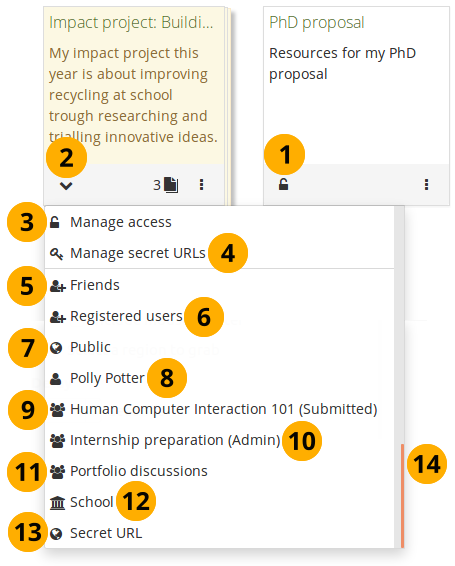
Review with whom you already shared your portfolio¶
Click the Unlocked icon to see with whom you have already shared your portfolio.
The icon turns into a downwards facing menu chevron . A drop-down menu opens.
Click the Manage access option to edit the existing sharing settings for your portfolio. You are taken to the Edit access screen where you can choose with whom to share your portfolio.
Click the Manage secret URLs option to create or edit a secret URL for your portfolio. You are taken to the Secret URLs screen where you can set up one or more secret URLs.
Friends: If you shared your portfolio with all your friends.
Registered users: If you gave all people with an account on your Mahara instance access to your portfolio.
Public: If you made your portfolio available to everyone on the internet.
Name of a person: If you shared your portfolio with a specific person.
Group name (Submitted): If you submitted this portfolio to a group.
Group name (Admin / Members / Tutors): If you shared your portfolio with only a certain type of group members in that group.
Group name: If you shared your portfolio with an entire group.
Institution name: If you shared your portfolio with all people in your institution.
Secret URL: If you set up a secret URL for your portfolio.
The drop-down menu has a scrollbar so you can view all people or groups of people with whom you shared your portfolio.
Note
Start or end dates or whether copying is allowed are not displayed in the drop-down menu. You need to go to the Share screen to see that additional information.
5.1.2.3. Access pages within a collection¶
You can view how many pages are part of a collection and what their titles are by clicking the Pages icon .
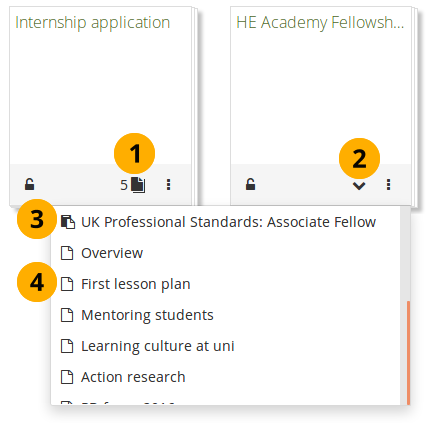
View a list of pages within a collection¶
Click the Pages icon .
Note

The icon depends on how many pages are in your collection:
0-2: One sheet of paper.
3-10: Two stacked sheets of paper.
11 or more: Three stacked sheets of paper.
The icon turns into a downwards facing menu chevron . A drop-down menu opens.
If you have a SmartEvidence collection, you see that listed first with the SmartEvidence page icon .
All other pages are are listed with the Single page icon .
Click the page you want to view.
5.1.2.4. More options¶
You can find additional options for pages or collections via the More options icon .
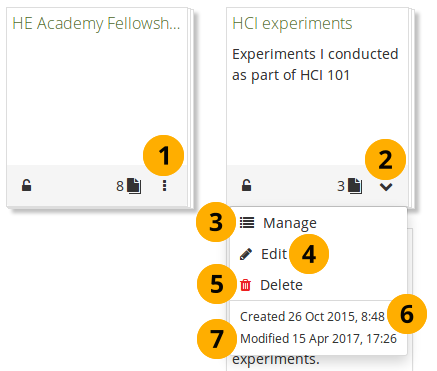
More options for pages and collections¶
Click the More options icon to see additional editing options.
The icon turns into a downwards facing menu chevron . A drop-down menu opens.
If you view the options for a collection, click Manage to add or remove pages from your collection.
Click Edit to edit the general information of a page or collection such as title, description, and tags.
Click Delete to delete the page or delete the collection.
Note
If you delete a collection, the pages and artefacts within it are not deleted.
Created: The date and time when you set up the page or collection.
Modified: The last time you made a change to the page or collection.
If you submitted a portfolio, you cannot edit or delete the page or collection until it has been released. Therefore, you don’t see those options anymore. However, you see when you submitted the portfolio to which group.
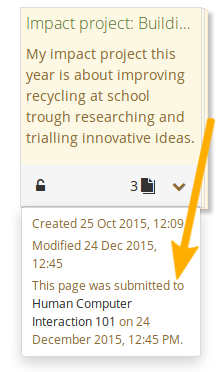
See submitted date and group¶
5.1.3. Profile page¶
Your profile page is visible to other users on Mahara by default. If your administrator allowed it, you can also make it visible to anybody on the Internet.
Per default only the following information is put onto your profile page:
Your display name (or real name if you do not have a display name)
Your pages that are visible to the person viewing your profile page
Your groups
Your wall
Your friends
We advise you not to use your profile page as your portfolio because you cannot control who can look at the information you make available on your profile. At minimum it is everybody in your institution or who has an account on Mahara. At maximum it can be everybody online. Always remember to think about your own personal security before releasing contact information on a publicly available page or even just for other Mahara users.
Note
Once you have made your profile page or any portfolio page public, Google and other search engines can index and cache it. Even if you take the public access away at some point, the cached version may still be available online. Pages that are made available via a secret URL are not found by search engines unless you link to them from another page.
Use regular pages to create your portfolio and your profile page as a business card or brief introduction to you without disclosing lots of details.
See also
You can edit your profile page like any other page. You can find more information about editing a page in the page editor.
5.1.4. Add a page¶
You add a new page in your portfolio when you want to display artefacts together, e.g. for presenting them to others, for showing your progress in a project etc.
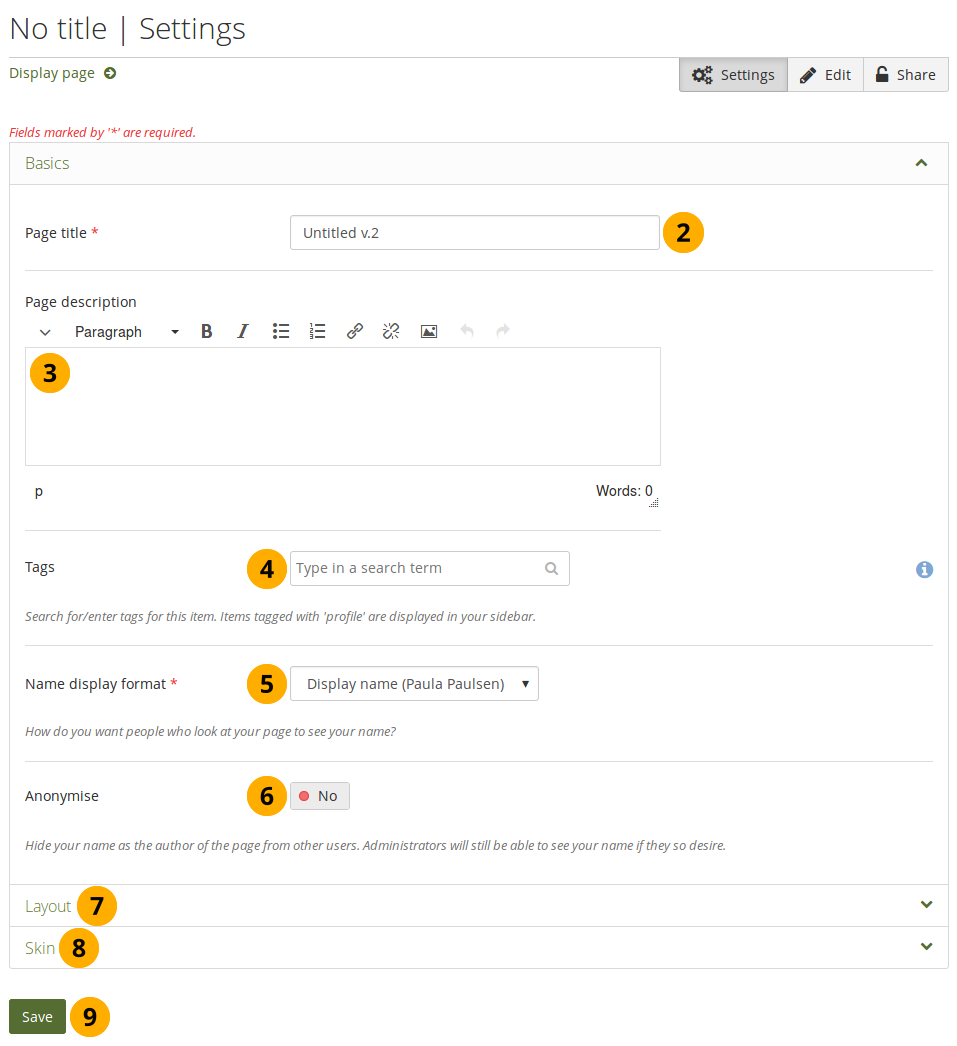
Create a portfolio page¶
On the Pages and collections page, click the Add button. In the modal that comes up, click the Page button. You are taken to the
 Settings screen.
Settings screen.Page title: Provide a title for your page. This field cannot be left empty. If you do not enter a title, the default “Untitled” will appear.
Note
 The page title, description, and tags appear in the Basics panel. If you cannot see them, click the icon to make them visible.
The page title, description, and tags appear in the Basics panel. If you cannot see them, click the icon to make them visible.Page description: Write a brief description summarising your objective of this page. It will appear on the page itself.
Tags: Enter tags to find your page more easily at a later stage. You can choose from your existing tags by starting to type a letter and then selecting the tag you want to use. You can also type a new tag, and it is added to your list of tags.
See also
You can find more information on how to use the tag selector in the “Tags” section.
Name display format: Choose how you want your name to appear on the page to others.
Anonymise: If the site administrator allowed anonymous pages, you can choose this option here. Instead of your (display) name, “Author’s name hidden” will be displayed to everyone. Administrators and staff can still see your real name.
 Layout: Click the icon to display all layout options. You can change the layout to decide the overall distributon of your blocks on the page.
Layout: Click the icon to display all layout options. You can change the layout to decide the overall distributon of your blocks on the page. Skins: Click the icon to select a skin for your page.
Skins: Click the icon to select a skin for your page.Click the Save button to save your changes and to continue to the Edit content part.
5.1.5. Edit an existing page¶
You can edit an existing page in two ways:
Click the Edit button when you are on the Pages overview page.
Click the Edit this page button when you are on the actual page.
See also
You find more information on how to edit artefacts on a portfolio page in the Edit content part.
If the site administrator activated clean URLs, your portfolio pages have human-readable URLs which you can change to a certain extend.
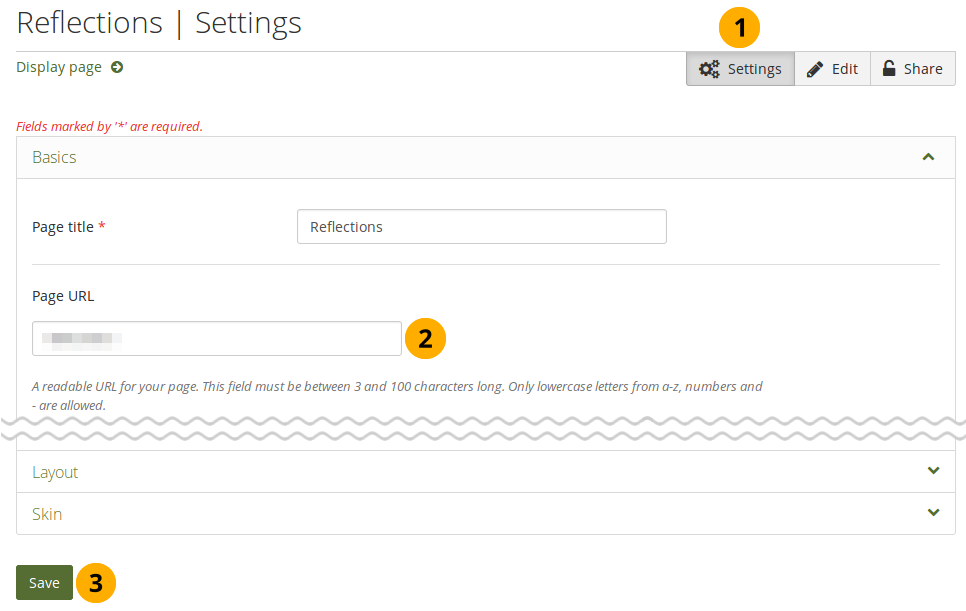
Change the URL for your portfolio page¶
When you are in the page edit mode, click the
 Settings button.
Settings button.Page URL: Choose the name for your page if you do not like the default one. It must be 3-30 characters long. You can only use lowercase letters from a-z, numbers and - (hyphen).
Click the Save button at the bottom of the page.
Warning
Though you can change the URL to your page at any point, you shouldn’t do that because people who already know the URL to your page will not be able to access it anymore after you have changed it.
The original, internal Mahara URL, e.g. http://mahara-university.org/view/view.php?id=789 will still work.
5.1.6. Add a collection¶
If you want to organize your portfolio into multiple pages so as to find individual sections more easily, you can create a collection that holds multiple pages.

Create a collection¶
On the Pages and collections page, click the Add button. In the modal that comes up, click the Collection button. On the next screen…
Collection name: Provide a title for your collection.
Collection description: Optionally, you can write a short description about your collection. You do not have a visual editor, but just a plain text box.
Tags: Enter tags to find your collection more easily at a later stage. You can choose from your existing tags by starting to type a letter and then selecting the tag you want to use. You can also type a new tag, and it is added to your list of tags.
Page navigation bar: Choose whether you wish to display a tabbed navigation or not. If you choose not to, you will have to include the navigation block for you to go from one page to the next on the individual pages that belong to this collection.
SmartEvidence framework: Select the framework that you want to associate with your collection. You can change the collection as long as you have not put an annotation onto a page within the collection.
Note
This functionality is available if your institution administrator allowed the use of SmartEvidence.
Click the Next: Edit collection pages button or click Cancel if you want to abort adding your collection.
5.1.7. Add pages to a collection¶
In the next step after you have created your collection, you choose which portfolio pages you wish to include in this collection. You see all the potential pages that you can use. If you had already placed a page into another collection, it is not shown here.
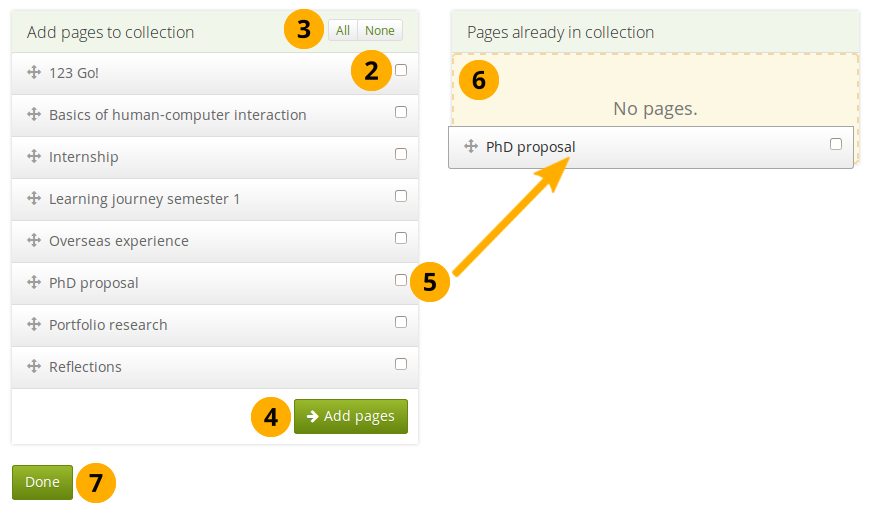
Add pages to a collection¶
On Portfolio → Pages and collections, click the More options icon for the collection and then the Manage icon . On the next screen…
Put a check mark next to each page that you wish to include in your collection.
Alternatively, you can click the All link to add all pages available to the collection or the None link to revert your selection.
Click the Add pages button to add the pages to your collection.
If you do not wish to click all pages, you can also drag and drop them into the collection by clicking their title and dragging them to the area Pages already in collection.
A dotted line shows you where you can drag your page so you can already drag the pages into the collection in the order that you prefer.
Click the Done button to finish this step.
5.1.8. Manage pages in a collection¶
Once you have added your pages to your collection. You can move them around or remove them.
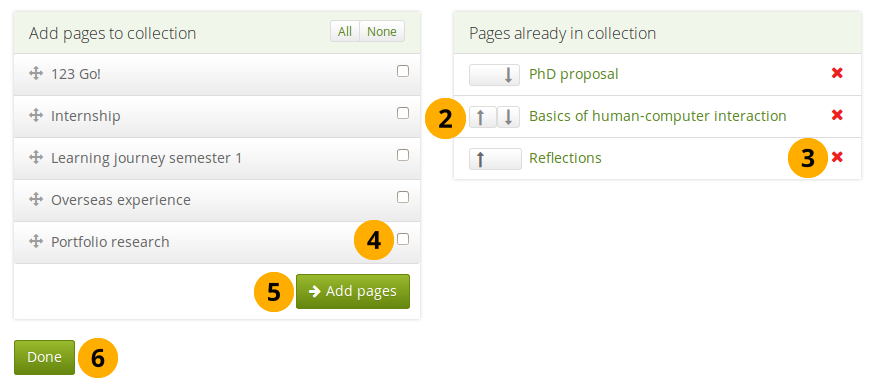
Manage the pages that are displayed within your collection¶
If you are not already in the page management, click the More options icon for the collection and then the Manage icon . On the next screen…
Use the Move up and Move down buttons to arrange your pages in a different order. Alternatively, you can drag and drop the pages within the list.
Click the Remove icon to take a page out of a collection. The page itself is not deleted.
Put a check mark next to each page that you wish to include in your collection in addition to the ones already in it.
Click the Add pages button to add the pages to your collection and then move them around with the Move up and Move down buttons. Alternatively, you can drag and drop the pages to the position where you would like to have them in the list.
Click the Done button.
When you add pages to your collection that have different access permissions than the collection has, the page’s access permissions get added to the collection and the page is available under the same access permissions as the entire collection because it is part of the collection.
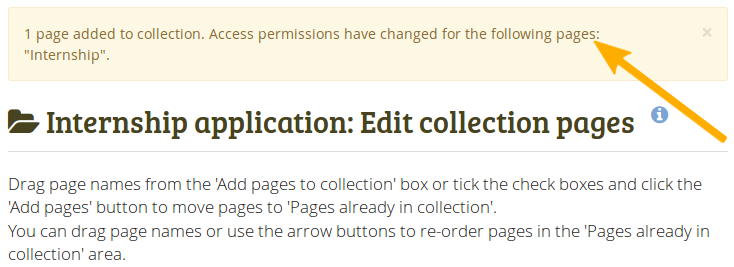
Notice about changes in permissions¶
If there is a change in access permissions, a warning will be displayed so that you are informed that changes have taken place.
View your collection by clicking on the collection title or any page that is part of your collection.
Note
 On a mobile device, you can swipe left and right to navigate through a collection when it has the page navigation bar.
On a mobile device, you can swipe left and right to navigate through a collection when it has the page navigation bar.
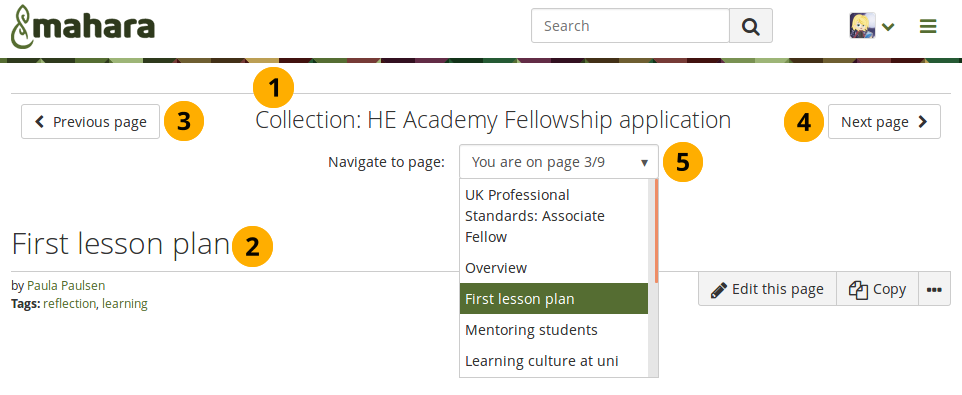
A collection with the page navigation bar¶
Title of the collection.
Title of the page you are currently viewing.
Previous page button to navigate to the previous page.
Next page button to navigate to the next page.
Navigate to drop-down menu: Select the page to which you want to jump within the collection.
5.1.9. Copy a portfolio¶
You can copy a portfolio by:
Clicking the Copy button when you view a portfolio and are allowed to copy it.
Searching for it.
5.1.9.1. Copy a portfolio directly from its location¶
You can copy a page or collection directly when you view it by clicking the Copy button when you see it. The button is displayed on your own pages and collections as well as on pages and collections owned by others when you have the permission to copy them.
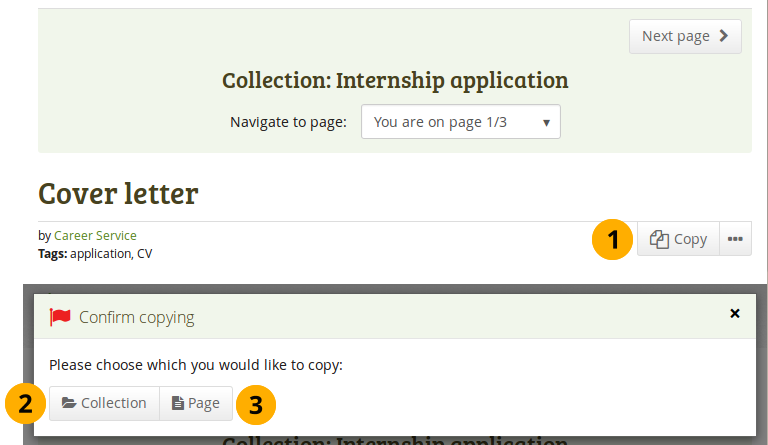
Copy a page or collection¶
Click the Copy button when you want to copy a page or collection that you can duplicate.
If the page is part of a collection, you need to decide in the pop-up window whether you want to copy the entire collection by clicking the Collection button…
Or just the page that you can see currently by clicking the Page button.
Edit the page or collection as you would do any other.
5.1.9.2. Copy a portfolio by searching for it¶
You can duplicate your own pages or pages of other users if they allowed you to do that.
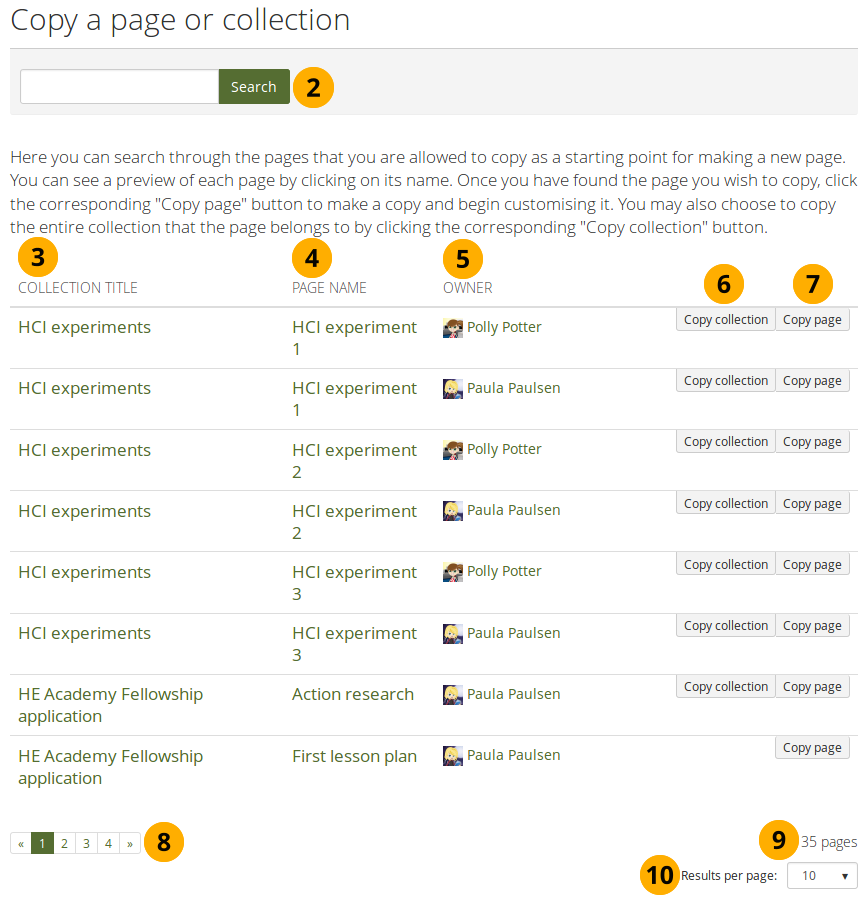
Copy a portfolio¶
Click the Copy button under Portfolio → Pages and collections. On the next screen…
Search: If there are many pages or collections from which you can choose, search here for a keyword in the page or collection title or for the name of the page owner.
Collection title: Click on the title of a collection to preview it before copying it.
Note
Results are listed alphabetically according to their collection title.
Page name: Click on the title of the page to see a preview of it before you copy it.
Owner: Click on the name of the owner to view a larger profile picture and the self description if the owner provided one or to see information about a group it that is the owner.
Note
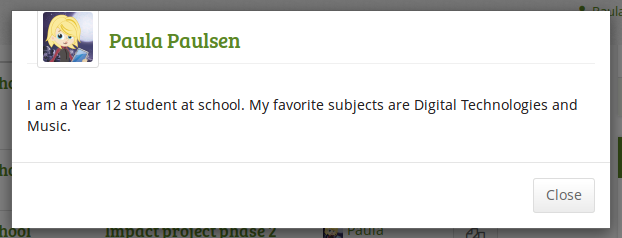
Click the Copy page button to copy one page only into your own portfolio or
Click the Copy collection button to copy an entire collection with multiple pages into your portfolio. All pages within this collection are copied.
You can navigate through the list of pages and collections to which you have access.
You see the total number of pages you can copy.
Results per page: Use this drop-down menu to change how many results you want to see per result page.
Edit the portfolio.
Note
If your copied pages and collections start with “Copy of”, the site administrator decided to have copies renamed.
5.1.10. View a page¶
You can view a page to check what it looks like when somebody else sees it. Go to the Pages and collections overview page and click on the title of a page.
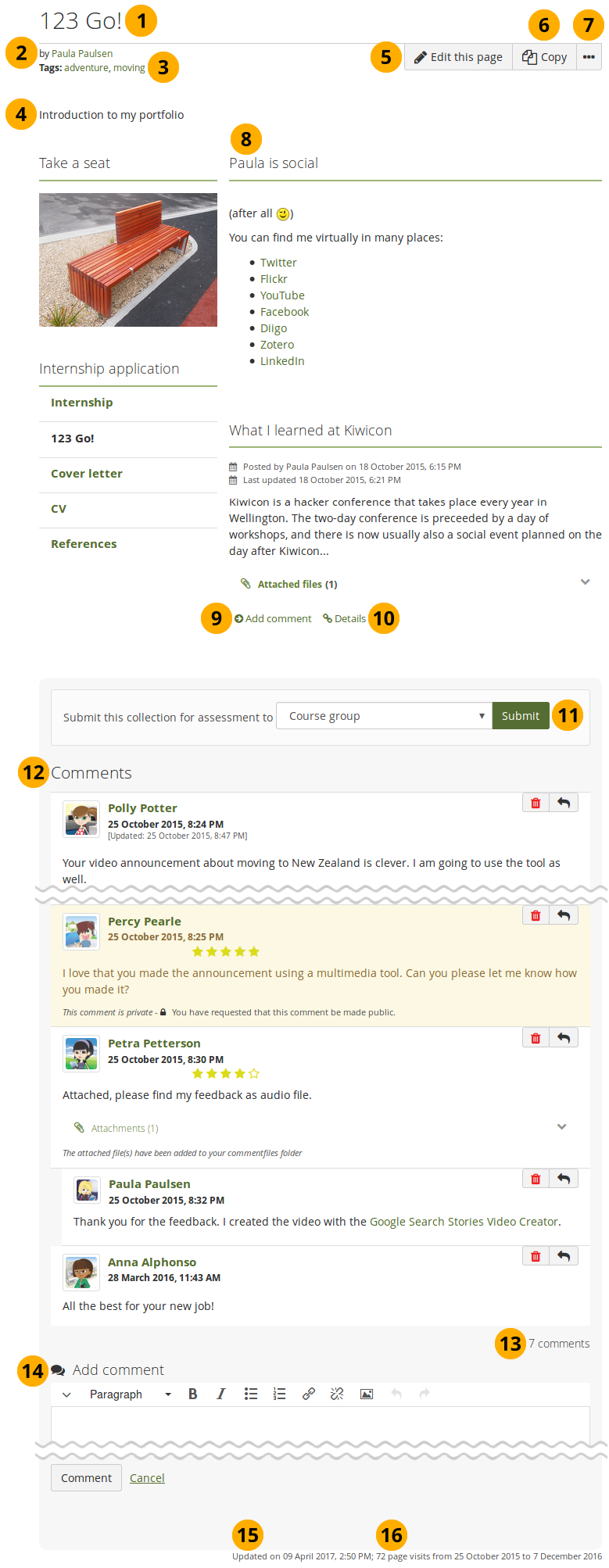
An example portfolio page.¶
Title of the portfolio page.
Author of the portfolio page.
Tags which you provided for your page.
Description of the page.
The Edit this page button is only visible if you are the page owner or belong to a group of users who can make changes to the page if it is in a group, institution or site level.
The Copy button is visible when you can copy the page or collection that you are viewing. You see it on your own pages as well as pages of others.
Click the More options button to reach lesser used functionality on a page.
Note
On your own pages you can:

Click the Print link to open the print dialogue. Using this print functionality, your portfolio pages are printed in the current layout, with collapsed blocks or artefacts uncollapsed so you can see their content easily. Note: Links are not yet active and linked files or embedded media are not accessible.
Click the Delete link to delete your page.
As someone viewing another person’s portfolio, you can:

Add or remove a page from your watchlist: Click the Add page to watchlist link if you want to be informed when changes are made to the page. When you make changes to the page or a block on the page, a notification is triggered and sent to anyone who is watching the page. This is also the case when you add a new journal entry to a journal that is displayed on your page even when you do not add the entry via the page. If you no longer wish to receive these notifications, remove the page from your watchlist by clicking the link Remove page from watchlist.
Report objectionable content for this page: If a page contains offensive artefacts, you can report them to the administrator and provide an explanation why you think the content is offensive.
These functionalities are only available on other people’s pages as they are not needed on your own.
The artefacts that you placed in the page.
Click the Add a comment link Add comment to be taken to the Details page for this artefact to leave a comment.
Click the Details icon Details to be taken to the Details page for this artefact if there is one.
If you belong to a group which allows the submission of pages for feedback / assessment, you see the group displayed here or can choose it from the drop-down menu and can submit your page directly from here. For more information see the section on feedback for assessment.
Comments from users is displayed at the bottom of the page unless you display it with the comments block elsewhere on the page. Each comment includes:
Profile picture and name of the commentator that are linked to the profile page.
The comment itself.
The creation date of the comment and potentially the last update date and time of the comment.
Comment rating.
Any attachments.
A note if the comment is private only to the commentator and the portfolio page author.
Note
For more information on giving and receiving comments, please see section Feedback.
The total number of comments is displayed.
You and others can use the Add comment section to leave comments on the page.
See also
Please refer to the section on making comments to see how that can be done.
Display the last update date and time of the page.
View how many times your page was accessed.
5.1.11. Give others access to your portfolio¶
See also
Please refer to the section on sharing your pages and collections for further information.
5.1.12. Delete a portfolio¶
You can delete a portfolio at any time unless it has been submitted for feedback.
Warning
When you delete a page, text blocks and external content blocks are completely deleted. You cannot recover them. There is no revision history. All other artefacts are not deleted because they reside in your Content area.
When you delete a collection, the pages and artefacts within it are not deleted.
If you are allowed to delete a page, you see the Delete this page option in the More options button when you view your page directly.

Click the “More options” button to find the “Delete” option¶
If you want to delete an entire collection, you can do so on Portfolio → Pages and collections by clicking the More options icon and then the Delete icon .
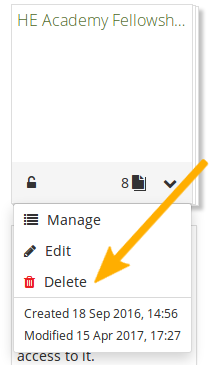
Delete a collection¶
When you attempt to delete a page or collection, you get the chance to export the portfolio first so that you can make an archive. If your page is part of a collection, the warning message also contains the title and a link to the collection for you to check whether you really want to delete the page and thus make changes to your collection.
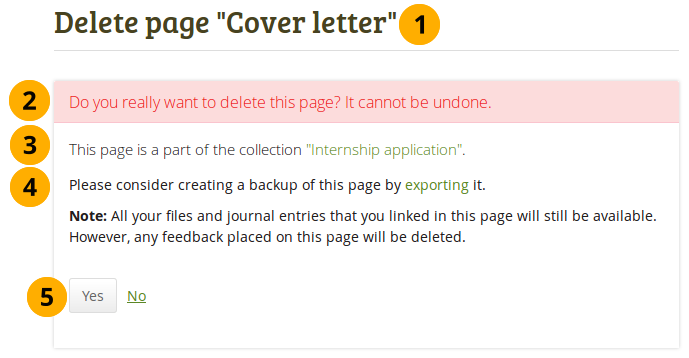
Warning when you attempt to delete a page that is in a collection¶
The title of the portfolio you are about to delete is displayed so you can double-check it is the correct one.
An explicit warning about the deleting of the portfolio is displayed. Deletion cannot be undone.
If you delete a page that is part of a collection, the collection is linked so you can view your collection and double-check deleting of the page is OK.
If you want to continue deleting your portfolio, you may want to export it first so you have a copy in case you do need it later again. Click the export link to be taken to the options for the export.
Note
We recommend you export your portfolio in both HTML and Leap2A formats so that you can view them without the need of Mahara (HTML) or can import them back into the same or another Mahara instance or another portfolio software that supports the Leap2A format.
Click the Yes button if you want to continue with the portfolio deletion or the No button if you want to keep it.
